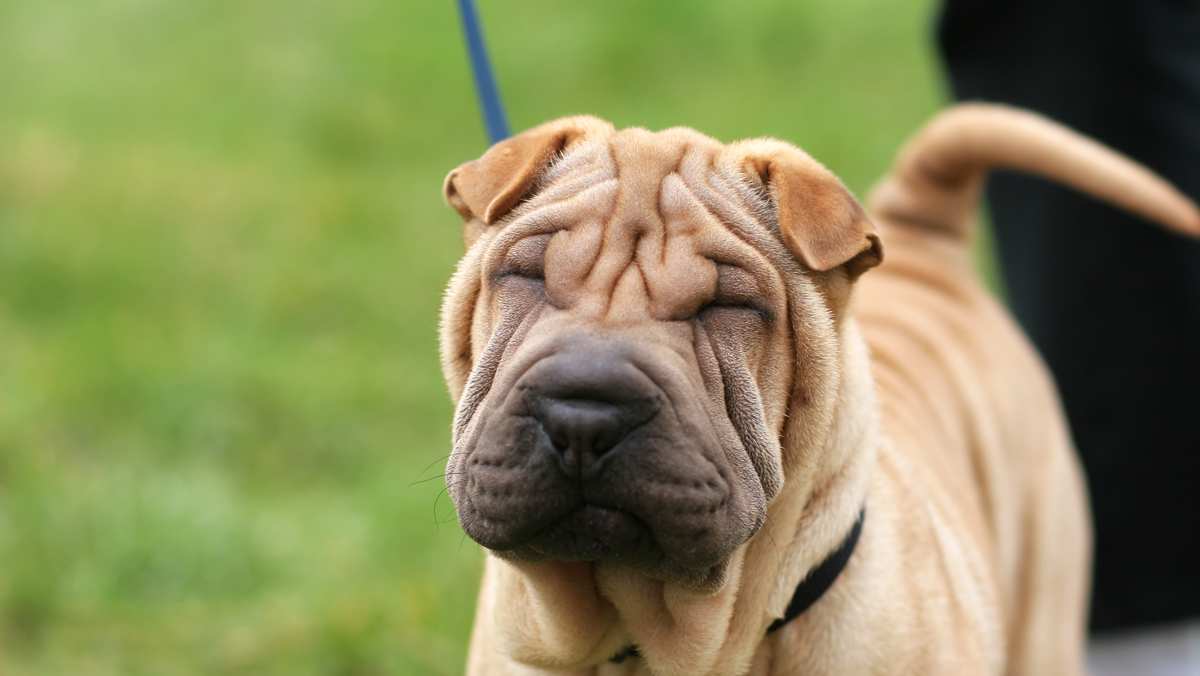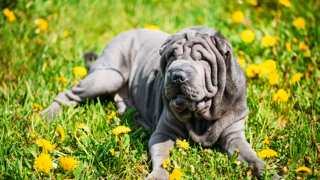Chinese Shar-pei Dog Breed
The Chinese Shar-Pei is a medium to large sized dog breed which was originally bred as a guarding, hunting, and herding dog. The breed is devoted to their family and will protect them from threats which makes the Shar Pei a good choice for a watchdog or guard dog.
The breed is both intelligent and free thinking, which can make the breed a bit stubborn. Because of this the Shar Pei will do best in a household with a strong leader, otherwise the Shar Pei may assume the role.
Chinese Shar-pei Breed Details
Many potential owners see only a Shar pei's wrinkly body and so-ugly-it's-cute face and think it must be the bred for them. This is the part where we outline benefits and potential problems of owning one of these dogs. The first question on a potential owner's mind is usually "Are Shar pei dangerous dogs?". The short answer is-- maybe. If he/she is raised with love and (equally as important) socialized and trained early then, no. Although they will still be extremely devoted and protective of you, they will understand threat vs non threat and will likely be reserved or non caring towards strangers. Now that we've addressed the most important question lets move on to these Shar pei facts:
Unforgettable appearance
Loyal, protective guard dog
Affectionate towards owner
Adaptable to apartments
Can be groomed at home
Exercise needs only moderate
Not needy, can be left alone for moderate periods
Intelligent
Can be aggressive if not properly socialized and trained
Not recommended for families with kids
Not hypoallergenic
May be too independent for some owners
May be difficult to train
Sensitive skin is prone to allergies, infections, etc
Many potential health issues
Not an intensive exercise partner
Purebred
8 - 12 yrs.
18 - 20 in.
40 - 55 lbs
OverallFamily FriendlyChild FriendlyPet FriendlyStranger Friendly
Easy to GroomEnergy LevelExercise NeedsHealthShedding Amount
Barks / HowlsEasy to TrainGuard DogPlayfulnessWatch Dog
Apartment DogCan be AloneGood for Busy OwnersGood for New OwnersIntelligence
Chinese Shar-pei Breed Description
The Shar Pei is between a medium and large sized dog breed. Owners can expect adults to stand 18-20 inches tall from ground to shoulder and weigh between 40-55 pounds. The breed is sturdy and calm, which makes them a good choice for apartments or smaller homes.
The Chinese Shar-Pei makes a wonderful family dog and is good with children. The breed will naturally want to protect their family from threats, so it is important to socialize the Shar Pei with other animals, children, and stranger at a young age so he/she won't be wary as an adult.
The Shar Pei is a low maintenance dog breed. Their coat is easy to care for and only need to be brushed once per week. Don't bathe the breed too often as it can irritate their skin. An easy walk once per day is all the exercise the breed needs. Their short snout makes it difficult for the Shar Pei to cool themselves easily, because of this they should not be used as running companions nor stay outside when it is hot.
Shar pei history is as rich as you could imagine such a unique dog's story to be. The breed comes from China and, like other Chinese breeds, is left fairly the same over thousands of years due to the country's former isolationist attitude. Early forms of this breed can be seen on artifacts dated as far back as 200 B.C. Hunting and herding, watching and guarding-- the Shar pei was a versatile and tough dog. The dogs remained a respectable guarding breed throughout this time until the communist revolution. Taxes were levied on pets until only the wealthy could afford to own one; as if this event did not decrease number of China's native dogs enough, the regime ordered the a mass killing of all dog breeds in 1949. What few Shar pei remained had decreased physical size and could only be found on islands off China's shore.
Sadly, the breed was popular in fighting circles around this time. They were compact, very tough and fierce but were quickly replaced by even larger, more aggressive bully breeds from other parts of the world. The Shar pei population reached an ultimate low during this time. This may have ended nearly ended the Shar pei dog's history had it not been for their export to a few other countries. The first one made it to America in 1966 and a Shar pei was featured on the cover of Life Magazine thanks to an appeal by a Hong Kong breeder to save the Shar pei. Demand for this new bizarre looking, wrinkly dog skyrocketed; they were desirable in advertisements and by the wealthy. The breed became the AKC's 134th in 1992.
The Shar pei is one of the most unique looking, easily recognizable dogs out there. Overall, the breed is medium-sized, compact and sturdy. Shar Pei are wrinkly dogs with short , rough fur. In fact, the fur has such a rough, harsh texture that the name Shar Pei translates as "sand skin". The coat can be a variety of solid colors (except white) and there may be areas that are shaded a little darker or lighter but still fall within the same color; for example, the Shar pei may have a tan coat with a light tan shading along the back but a tan Shar pei will not have white, black or any other color markings. The fur stands straight like bristles off the main body but lays close on the legs. You may hear it referred to as "horse coat" or "brush coat" which refers to the length-- it ranges from extremely short (horse) up to 1 inch (brush).
Moving on to the characteristic head. It is large and round with a "hippopotamus like" wide nose. The small eyes are deep set and look as if they are struggling to hold up the dog's wrinkled forehead. Don't let this fool you, they are very sharp eyed dogs-- very alert and intelligent! The Shar pei tongue is also very interesting because it is unusually a bluish black as are the gums and top on the mouth. Some lighter toned Shar pei have lavender tongues. The head is not complete without the tiny, triangular ears that seem completely in contrast with the big, wrinkle covered skull.
The images below represent the coat colors and patterns associated with Shar-Pei.
Black Sable
Blue Dilute
Blue Sable
Brown Sable
Chocolate Dilute
Cream Sable
Fawn Sable
Five Point Red Dilute
Isabella Dilute
Red Fawn
Red Sable
The Shar pei dog breed has few variations among individuals and there are no specified types. The coat has 2 acceptable states: horse coat and brush coat. Horse coat Sharpei puppies will grow to the the most common type that we know to have the very short, bristly rough fur. The brush coat will still be harsh but is longer than the horse coat, although it is not to exceed 1 inch. There is also a recessive gene that displays in some Shar pei as a "bear coat". This coat style is rare, popular and not at all accepted as standard.
Note that before seeking bear coat Shar pei puppies for sale you should know this coat type is not considered standard by most kennel clubs--so you will not be able to show your dog. This is likely because Shar pei puppies are not supposed to be fluffy; a defining characteristic of the breed is the short, rough hair.
The Shar Pei temperament is dignified. They are reserved in general and will not usually interact with strangers or other dogs unless they perceive a threat-- then their intense loyalty to their owner can provoke them to be aggressive if necessary. Another characteristic of Shar pei is that they are very calm and independent; although they are not a good choice for those seeking an affectionate velcro dog, they are perfect for a busy owner. It is a great comfort to many owners to know that their Shar pei are not pining away and destroying the house while they are at work. These dogs are alert and make excellent guard dogs, however, they will need early socialization and training to understand the difference between an actual threat and a passerby. The breed, although intelligent, is not easily trained and it is recommended to be consistent and firm with them. A fully grown Shar pei with no training could be a hazard to others.
Owning a Shar Pei is pretty much a mixed bag. While these dogs don't require a ton of maintenance and care, they will need some training and supervision in order to teach them proper obedience. Shar Peis don't bark too much, but they can be defensive and overly protective around unknown people and animals. Overall, Shar Pei as pets are best for people looking for a calm watchdog type, and people who have time to train the dog.
In terms of housing, Shar Peis are best suited to living in homes with fenced yards. They'll be okay in apartments too---but regardless, they'll need a moderate amount of outdoor exercise each day.
And are Shar Peis hypoallergenic? In short, they're not. The Shar Pei hypoallergenic tendencies are basically zero because they shed regularly--so allergy sufferers will do better choosing another breed.
There was a period where the Chinese Shar pei dog breed was very sought after and, therefore, over-bred. This caused several unusual, breed specific health issues. We have outline many below and the Chinese Shar-Pei Club of America has a very thorough and detailed list if you should need more information. Bear in mind your Shar-pei puppy may live a long, healthy life without ever experiencing any of these health problems; the list is just here to so as to inform owner of all possibilities.
- Eye issues are very common to the breed. Primary lens luxation, entropion, glaucoma and cataracts are just a few examples.
- Allergies
- Skin problems such as mange, pyoderma and cutaneous mucinosis are common due to the heavily wrinkled skin.
- SPAID is a term for a host of inflammatory conditions that affect different body systems of the Shar pei.
- Gastrointestinal issues
- Thyroid disorders
- Immune deficiencies
- Muscle and joint disorders
Some things you can do to ensure your Shar pei has the best chance to be healthy include: making sure the skin folds stay clean and dry, feeding them the appropriate amount to prevent excessive weight gain, and maintaining regular veterinary appointments. If you plan to get a Chinese Shar Pei puppy from a breeder, do thorough research to find one with a good reputation.
Below are potential health concerns associated with Shar-Pei.
Bloat
Cancer
Entropion
Hip dysplasia
Patellar luxation
Hypothyroidism
Elbow dysplasia
Osteochondritis Dissecans
Demodectic mange
Glaucoma
Fever
Seborrheic dermatitis
Pyoderma
Cutaneous mucinosis
Some interesting facts about the breed:
- The wrinkles are a defense mechanism: According to historians, the Shar-Pei's wrinkles were developed to help them in dog fights. If another dog latched on to the loose skin, the Shar-Pei could get away without sustaining any internal injuries.
- "Ugly Shar-Pei" Christmas apparel: Some clothing lines offer comically hideous holiday-themed sweaters and T-shirts with an "Ugly Shar-Pei" logo, complete with the breed's image on the front.
- World's Rarest Dog Breed: For much of the late 20th century, the Guinness Book of World Records listed the Shar-Pei as the rarest dog breed on Earth. The breed has made a comeback in recent decades, but is still difficult to obtain.
- Celebrity Shar-Pei owners: Well-known personalities past and present have owned Shar-Pei dogs, including Johnny Carson, New Kids on the Block member Jordan Knight, William Shatner, Gordon Ramsay, and David Beckham.











